Ask Crystal: Looking for Love – Adding a New Pet

Hi! I want to get another dog because one of my dogs I had to put down and my other dog is 11 years old and a female. The only other dogs she knows are neighbor dogs, but I am afraid of what she would do. Help, how can I know?
Sincerely,
Looking for Love
Dear Looking,
This is a really good question and I appreciate that you are asking yourself if it’s a good idea to add another dog. It’s a tough decision and one that should be considered thoughtfully. There are a lot of factors to whether two dogs will get along and definitely ways to introduce them which will be safer and more likely to lead to a better relationship.
Besides considering your dog, you should also consider yourself and your current life situation before adopting. Bringing a new animal home is stressful for most people. And if it isn’t stressful right away, there are likely going to be stressful times ahead. Be sure you are at a place in life where you are not experiencing any big life changes and have the time to dedicate to a new animal and the training it needs.
It is important to note your dog’s experience with other dogs. If she doesn’t have dogs come into her house frequently or interact with new dogs frequently then it probably will be an adjustment and stressful for her. She is a bit older, and dogs tend to be more selective as they get older. This usually means that they need more time to adjust to a new friend in the house and breaks from the new pup while they are getting used to them.
When she plays with the neighbor dogs, I would look at how she interacts with them and what preferences she shows. Dogs have personality preferences just like humans do. When they are puppies, they usually like most other dogs but as they age, they tend to prefer certain personalities more. Does she do better with a calmer dog or enjoy a playful dog? Is she the type that wants to be in charge or deferential to most other dogs?
In general, the best pairings are opposite sex pairings. Males can be fine together especially if they are both neutered. Females tend to have the most problems with each other, so I usually recommend that they be very different in personality, size and age. When two females are too similar, that tends to be when they clash. I think it’s easier to go with a male in this situation. If she is bossy, then look for a deferential personality.
The other part of the puzzle is the energy level of the dog. Most older dogs can’t really keep up or enjoy puppy energy. That doesn’t mean that they can’t be a good fit. It just means that you really can’t really on the other dog to wear the young dog out. In my personal experience, that doesn’t happen anyways. I have two very energetic young dogs and all they seem to do is amp each other up! Just be aware that unless you adopt another senior dog, you will likely need to work on burning energy and training. I would suggest a dog five and over to get a nice balance of energy or adopt another senior dog and they will have similar energy levels. I love the laid-back energy of a senior dog.
The first part of the equation is just being really honest with yourself about your own lifestyle and what a good fit is for you. When you go to the shelter, be really honest about your life and let them help you choose a dog. So many people choose a dog based on appearance alone and that is not a good way to pick a dog. It doesn’t account for the individual personality. The shelter staff will usually know a bit more about the personality even if they don’t know everything.
Next, plan out how you will set the dog up in your home when you bring it home. In the old days, people just brought a new dog home, walked it in the house and just expected the dogs to work it out. That is really not the best way to approach it and will cause stress and strife which can lead to fights. There is a thoughtful and careful way to introduce dogs.
Study up on dog body language and be sure you know how to read how the dogs are feeling when they are interacting. Their body language will help to tell you when they are ready to move on to the next step. Basically, the goal is for them to be totally bored with the other dog at whatever level you are at before you move on. An example is when I introduced the new dog to the cats through the baby gate, he was standing very still and staring at them very focused. By the end of weeks of work, he was paying more attention to me and able to walk around and not stare into the room with the cats.
It’s always a good idea to first introduce the dogs on neutral territory first so your dog isn’t territorial when they first meet. Most shelters will facilitate this, or you can get a friend to help handle one of the dogs at a park. This introduction is not a one and done but it will give you information about how she is potentially going to react to a new dog and then how that dog responds to her. This can give an indication of how much time the introduction might take. Grumpy older dogs can take longer to introduce.
Start out by taking a tandem walk with each dog walking on opposite sides of the handlers. They shouldn’t be able to reach each other yet. Just get them in the rhythm of walking and give them time to calm down. Once they are calm, you can let them greet for 3 seconds. I say 3 second because that is usually not long enough for anything bad to happen. Watch their body language. We are looking for loose wiggly curvy bodies. If they are still and stiff, get moving again. If there is any reactivity like barking or growling, give them more space until they are not doing that. I usually take a walk like this daily with new dogs and that is the majority of how they see each other in the beginning days.
When you get home, do the same walk in the backyard. If they seem loose and wiggly, you can let them drag leashes around the back yard and see how they do. Interrupt any stiffness by moving the dogs away from each other. Keep this session short. Then move the new dog inside while the resident dog stays outside. Let the new dog check out the house and then put him in his room. In his room, there should be a crate and a baby gate on the door. Leave the crate door open but make it nice and cozy. He should stay in here or you can switch the resident dog into a crate and let the new dog come out. The idea is that in the beginning we are limiting the interactions inside the house.
There are certain areas of houses that tend to be more stressful for new dogs. Doorways, hallways and any narrow space can cause tension if both dogs are in them. Kitchens are also very meaningful since food comes from there. The other way to keep things chill is to pick up any toys. Do not feed in the same room. Avoid treating the dogs right next to each other and petting them right next to each other.
The next step is to let them see each other through the baby gate and reward calmly looking at the other dog and looking at you. They should be able to eat and respond to cues. Do this for a few minutes throughout the day. Then you can move on to having the dogs in the same room. I usually put the new dog on a tie down and toss treats for calmly laying there.
The next step, the dogs can be loose in the house together, but they are dragging leashes so that if anything were to happen, you could separate them. Never reach in to grab collars if dogs get into a fight. The first thing to do is to make a very loud noise to startle them. You can also throw water on them or a blanket on one of them. Usually, most normal fights are just a lot of noise and will break up with a loud sound.
Lastly, you may be able to start allowing some unsupervised time together by going outside and listening to make sure nothing is happening. Slowly increase the amount of time you leave them alone. I will note though that some dog pairs can’t be left together unsupervised, and one should be put away before you leave.
The goal is to avoid the dogs ever getting into a fight which is why we need to take the time to slowly expose them. I have seen so many people return dogs that they introduced to the other dog with no precautions the first day and it went poorly. Dogs need a decompression period before attempting introductions and they need to be done in a safe, thoughtful way. Some dogs will breeze right through all the steps, and it can only take days and some take weeks. Just because a dog is growling at first doesn’t mean it can’t get used to the other dog if given time to acclimate.
Certified Professional Dog Trainers can help you pick out the right dog for your family and help you with the introduction process. Locate a trainer here: Certified Dog Trainer and Behavior Consultant Directory – CCPDT Good luck in finding a new family member!
Until next time,
Crystal
Submit your own pet behavior question for Crystal here:







